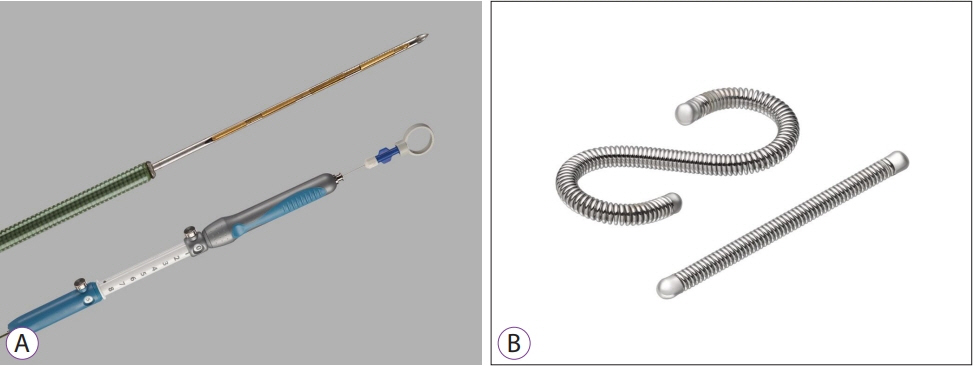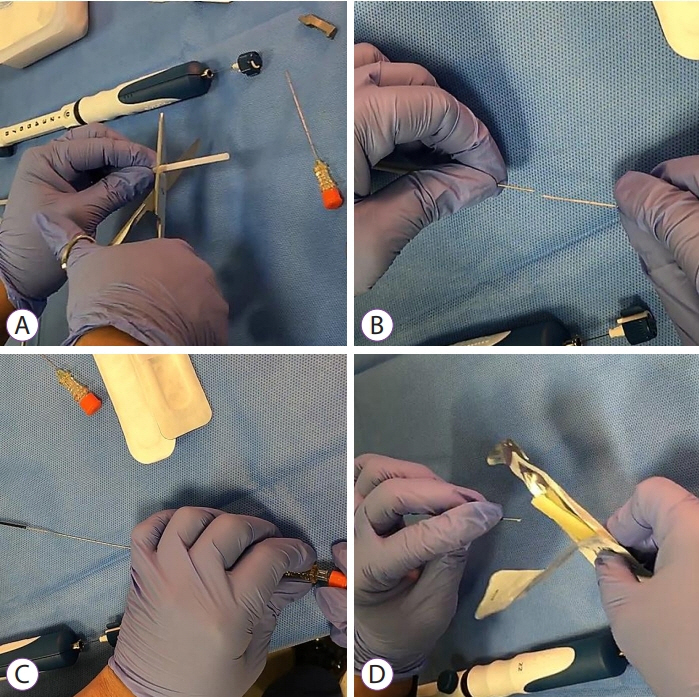Clin Endosc.
2021 May;54(3):314-323. 10.5946/ce.2021.102.
Endoscopic Ultrasound–Guided Fiducial Placement for Stereotactic Body Radiation Therapy in Pancreatic Malignancy
- Affiliations
-
- 1Department of Internal Medicine, Research Institute of Clinical Medicine of Jeonbuk National University-Biomedical Research Institute of Jeonbuk National University Hospital, Jeonju, Korea
- 2Division of Gastroenterology and Hepatology, Johns Hopkins University, Baltimore, MD, USA
- KMID: 2516310
- DOI: http://doi.org/10.5946/ce.2021.102
Abstract
- Stereotactic body radiation therapy (SBRT) is an important treatment option for pancreatic cancer, which is known to be one of the malignancies with the worst prognosis. However, the high radiation doses delivered during SBRT may cause damage to adjacent radiosensitive organs. To minimize such damage, fiducial markers are used for localization during SBRT for pancreatic cancer. The development of endoscopic ultrasound (EUS) has enabled fiducial markers to be inserted into the pancreas using an EUS fine-needle aspiration (FNA) needle, unlike in the past when percutaneous placement was generally performed. For successful EUS-guided fiducial marker placement, it is necessary for the fiducial markers to be loaded within the EUS-FNA needles to have a low probability of complications and a low migration risk, and to be stably observed in SBRT imaging. A systematic review has shown that the technical success rate of EUS-guided fiducial marker placement is 96.27%, whereas the fiducial marker migration and adverse event rates are 4.33% and 4.85%, respectively. Nonetheless, standardized techniques for fiducial marker placement and the characteristics of optimal fiducial markers have not yet been established. This review will introduce the characteristics (e.g., materials and shapes) of fiducial markers used in fiducial marker placement for pancreatic cancer and will discuss conventional techniques along with their success rates, difficulties, and adverse events.
Keyword
Figure
Reference
-
1. Siegel RL, Miller KD, Jemal A. Cancer statistics, 2020. CA Cancer J Clin. 2020; 70:7–30.
Article2. Kerdsirichairat T, Shin EJ. Role of endoscopic ultrasonography guided fiducial marker placement in gastrointestinal cancer. Curr Opin Gastroenterol. 2020; 36:402–408.
Article3. Gurka MK, Kim C, He AR, et al. Stereotactic body radiation therapy (SBRT) combined with chemotherapy for unresected pancreatic adenocarcinoma. Am J Clin Oncol. 2017; 40:152–157.
Article4. Conroy T, Bachet J-B, Ayav A, et al. Current standards and new innovative approaches for treatment of pancreatic cancer. Eur J Cancer. 2016; 57:10–22.
Article5. Chauffert B, Mornex F, Bonnetain F, et al. Phase III trial comparing intensive induction chemoradiotherapy (60 Gy, infusional 5-FU and intermittent cisplatin) followed by maintenance gemcitabine with gemcitabine alone for locally advanced unresectable pancreatic cancer. Definitive results of the 2000-01 FFCD/SFRO study. Ann Oncol. 2008; 19:1592–1599.
Article6. Loehrer PJ, Feng Y, Cardenes H, et al. Gemcitabine alone versus gemcitabine plus radiotherapy in patients with locally advanced pancreatic cancer: an eastern cooperative oncology group trial. J Clin Oncol. 2011; 29:4105–4112.
Article7. de Geus SWL, Eskander MF, Kasumova GG, et al. Stereotactic body radiotherapy for unresected pancreatic cancer: a nationwide review. Cancer. 2017; 123:4158–4167.
Article8. Petrelli F, Comito T, Ghidini A, Torri V, Scorsetti M, Barni S. Stereotactic body radiation therapy for locally advanced pancreatic cancer: a systematic review and pooled analysis of 19 trials. Int J Radiat Oncol Biol Phys. 2017; 97:313–322.
Article9. Slagowski JM, Colbert LE, Cazacu IM, et al. Evaluation of the visibility and artifacts of 11 common fiducial markers for image guided stereotactic body radiation therapy in the abdomen. Pract Radiat Oncol. 2020; 10:434–442.
Article10. Moningi S, Abi Jaoude J, Kouzy R, et al. Impact of fiducial marker placement before stereotactic body radiation therapy on clinical outcomes in patients with pancreatic cancer. Adv Radiat Oncol. 2021; 6:100621.
Article11. Pishvaian AC, Collins B, Gagnon G, Ahlawat S, Haddad NG. EUS-guided fiducial placement for CyberKnife radiotherapy of mediastinal and abdominal malignancies. Gastrointest Endosc. 2006; 64:412–417.
Article12. Bhutani MS, Herman JM. Endoscopic ultrasound-guided fiducial placement for gastrointestinal malignancies. Gastroenterol Hepatol (N Y). 2019; 15:167–170.13. Chavalitdhamrong D, DiMaio CJ, Siersema PD, Wagh MS. Technical advances in endoscopic ultrasound-guided fiducial placement for the treatment of pancreatic cancer. Endosc Int Open. 2015; 3:E373–E377.
Article14. Han J, Chang KJ. Endoscopic ultrasound-guided direct intervention for solid pancreatic tumors. Clin Endosc. 2017; 50:126–137.
Article15. Majumder S, Berzin TM, Mahadevan A, et al. Endoscopic ultrasound- guided pancreatic fiducial placement: how important is ideal fiducial geometry? Pancreas. 2013; 42:692–695.16. Coronel E, Cazacu IM, Sakuraba A, et al. EUS-guided fiducial placement for GI malignancies: a systematic review and meta-analysis. Gastrointest Endosc. 2019; 89:659–670.e18.17. Ammar T, Coté GA, Creach KM, Kohlmeier C, Parikh PJ, Azar RR. Fiducial placement for stereotactic radiation by using EUS: feasibility when using a marker compatible with a standard 22-gauge needle. Gastrointest Endosc. 2010; 71:630–633.
Article18. DiMaio CJ, Nagula S, Goodman KA, et al. EUS-guided fiducial placement for image-guided radiation therapy in GI malignancies by using a 22-gauge needle (with videos). Gastrointest Endosc. 2010; 71:1204–1210.19. Park WG, Yan BM, Schellenberg D, et al. EUS-guided gold fiducial insertion for image-guided radiation therapy of pancreatic cancer: 50 successful cases without fluoroscopy. Gastrointest Endosc. 2010; 71:513–518.
Article20. Choi J-H, Seo D-W, Park DH, Lee SK, Kim M-H. Fiducial placement for stereotactic body radiation therapy under only endoscopic ultrasonography guidance in pancreatic and hepatic malignancy: practical feasibility and safety. Gut Liver. 2014; 8:88–93.
Article21. Sanders MK, Moser AJ, Khalid A, et al. EUS-guided fiducial placement for stereotactic body radiotherapy in locally advanced and recurrent pancreatic cancer. Gastrointest Endosc. 2010; 71:1178–1184.
Article22. Varadarajulu S, Trevino JM, Shen S, Jacob R. The use of endoscopic ultrasound-guided gold markers in image-guided radiation therapy of pancreatic cancers: a case series. Endoscopy. 2010; 42:423–425.
Article23. Khashab MA, Kim KJ, Tryggestad EJ, et al. Comparative analysis of traditional and coiled fiducials implanted during EUS for pancreatic cancer patients receiving stereotactic body radiation therapy. Gastrointest Endosc. 2012; 76:962–971.
Article24. Dávila Fajardo R, Lekkerkerker SJ, van der Horst A, et al. EUS-guided fiducial markers placement with a 22-gauge needle for image-guided radiation therapy in pancreatic cancer. Gastrointest Endosc. 2014; 79:851–855.
Article25. Dhadham GC, Hoffe S, Harris CL, Klapman JB. Endoscopic ultrasound- guided fiducial marker placement for image-guided radiation therapy without fluoroscopy: safety and technical feasibility. Endosc Int Open. 2016; 4:E378–E382.26. Tabernero S, Prados S, Rubio MDC, de la Morena F, López M, Sánchez E. Endoscopic ultrasound-guided fiducial placement in pancreatic tumors: safety and technical feasibility. Rev Esp Enferm Dig. 2019; 111:425–430.
Article27. Nair VJ, Szanto J, Vandervoort E, et al. Feasibility, detectability and clinical experience with platinum fiducial seeds for MRI/CT fusion and real-time tumor tracking during CyberKnife® stereotactic ablative radiotherapy. J Radiosurg SBRT. 2015; 3:315–323.28. Gleeson FC, Tryggestad EJ, Remmes NB, et al. Knowledge of endoscopic ultrasound-delivered fiducial composition and dimension necessary when planning proton beam radiotherapy. Endosc Int Open. 2018; 6:E766–E768.
Article29. Hamstra DA, Mariados N, Sylvester J, et al. Continued benefit to rectal separation for prostate radiation therapy: final results of a phase III trial. Int J Radiat Oncol Biol Phys. 2017; 97:976–985.30. Rao AD, Feng Z, Shin EJ, et al. A novel absorbable radiopaque hydrogel spacer to separate the head of the pancreas and duodenum in radiation therapy for pancreatic cancer. Int J Radiat Oncol Biol Phys. 2017; 99:1111–1120.
Article31. Rao AD, Shin EJ, Beck SE, et al. Demonstration of safety and feasibility of hydrogel marking of the pancreas-duodenum interface for image guided radiation therapy (IGRT) in a porcine model: implications in igrt for pancreatic cancer patients. Int J Radiat Oncol Biol Phys. 2018; 101:640–645.
Article32. Kerdsirichairat T, Narang AK, Thompson E, et al. Feasibility of using hydrogel spacers for borderline-resectable and locally advanced pancreatic tumors. Gastroenterology. 2019; 157:933–935.
Article33. de Souza Lawrence L, Ford E, Gilbert C, et al. Novel applications of an injectable radiopaque hydrogel tissue marker for management of thoracic malignancies. Chest. 2013; 143:1635–1641.
Article34. Ussui V, Kuritzky N, Berzosa M. Mo1992 EUS-guided liquid fiducial placement for stereotactic radiotherapy in pancreatic cancer: feasibility study. Gastrointestinal Endoscopy. 2016; 83:AB486–AB487.
Article35. Ussui V, Kuritzky N, Berzosa M. EUS-guided liquid fiducial placement for stereotactic radiotherapy in pancreatic cancer: feasibility study. Endosc Ultrasound. 2018; 7:135–136.36. Machicado JD, Obuch JC, Goodman KA, et al. Endoscopic ultrasound placement of preloaded fiducial markers shortens procedure time compared to back-loaded markers. Clin Gastroenterol Hepatol. 2019; 17:2749–2758.e2.
Article37. Owens DJ, Savides TJ. EUS placement of metal fiducials by using a backloaded technique with bone wax seal. Gastrointest Endosc. 2009; 69:972–973.
Article38. Khara HS, Pineda-Bonilla JJ, Chaput KJ, Johal AS. Endoscopic ultrasound- guided placement of fiducial markers using a novel “wet-fill technique” without a bone wax seal. Endoscopy. 2013; 45 Suppl 2 UCTN:E426–E427.39. Patel JB, Revanur V, Forcione DG, Bechtold ML, Puli SR. Endoscopic ultrasound-guided fiducial marker placement in pancreatic cancer: a systematic review and meta-analysis. World J Gastrointest Endosc. 2020; 12:231–240.
Article40. Kerdsirichairat T, Kim S-H, Narang A, et al. Mo1276 Visibility, artifact and migrations using three types of fiducials for pancreatic ductal adenocarcinoma (PDAC) patients receiving stereotactic body radiation therapy (SBRT). Gastrointestinal Endoscopy. 2018; 87:AB426.
Article
- Full Text Links
- Actions
-
Cited
- CITED
-
- Close
- Share
- Similar articles
-
- Fiducial Placement for Stereotactic Body Radiation Therapy under Only Endoscopic Ultrasonography Guidance in Pancreatic and Hepatic Malignancy: Practical Feasibility and Safety
- Endoscopic Ultrasound-Guided Direct Intervention for Solid Pancreatic Tumors
- Novel diagnostic and therapeutic modalities using endoscopic ultrasound in pancreatic disease
- Assessment of real-time US-CT/MR-guided percutaneous gold fiducial marker implementation in malignant hepatic tumors for stereotactic body radiation therapy
- Technical tips for endoscopic ultrasound-guided pancreatic duct access and drainage




